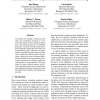Free Online Productivity Tools
i2Speak
i2Symbol
i2OCR
iTex2Img
iWeb2Print
iWeb2Shot
i2Type
iPdf2Split
iPdf2Merge
i2Bopomofo
i2Arabic
i2Style
i2Image
i2PDF
iLatex2Rtf
Sci2ools
ACL
2008
2008
Bayesian Learning of Non-Compositional Phrases with Synchronous Parsing
We combine the strengths of Bayesian modeling and synchronous grammar in unsupervised learning of basic translation phrase pairs. The structured space of a synchronous grammar is a natural fit for phrase pair probability estimation, though the search space can be prohibitively large. Therefore we explore efficient algorithms for pruning this space that lead to empirically effective results. Incorporating a sparse prior using Variational Bayes, biases the models toward generalizable, parsimonious parameter sets, leading to significant improvements in word alignment. This preference for sparse solutions together with effective pruning methods forms a phrase alignment regimen that produces better end-to-end translations than standard word alignment approaches.
| Added | 29 Oct 2010 |
| Updated | 29 Oct 2010 |
| Type | Conference |
| Year | 2008 |
| Where | ACL |
| Authors | Hao Zhang, Chris Quirk, Robert C. Moore, Daniel Gildea |
Comments (0)

